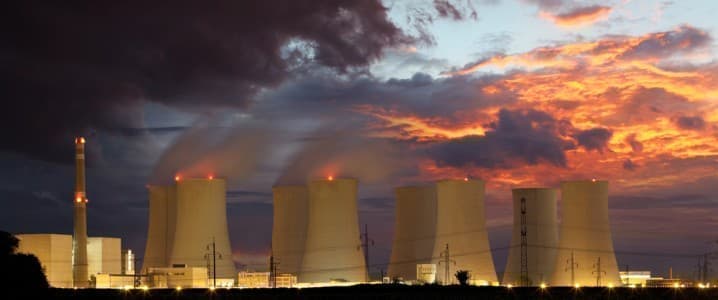Business
Global Nuclear Power Generation Reaches Record Heights in 2024

Nuclear power generation has achieved a significant milestone, reaching a global output of 2,817 terawatt-hours (TWh) in 2024. This figure marks a modest increase from 2023 and surpasses the previous record set in 2021. While this growth is notable, it is accompanied by a complex landscape where some nations are advancing rapidly while others are retreating from nuclear energy.
Growth Patterns Diverge Globally
In the past decade, global nuclear generation has experienced a 2.6% annual growth rate, indicating a gradual recovery from the downturn following the Fukushima disaster. This growth is particularly pronounced in non-OECD countries, which are expanding their nuclear capacities at an impressive 3.0% annually. In contrast, OECD nations have seen a stagnant or declining trend at 2.5%.
The most striking developments are occurring in the Asia Pacific region, which now accounts for over 28% of global nuclear output—more than double its share from a decade ago. This shift signifies a geopolitical change, with nuclear power increasingly being driven by nations with state-led infrastructure strategies rather than traditional Western democracies.
The United States remains the leading nation in nuclear output, contributing approximately 850 TWh annually, which constitutes 29.2% of the world’s nuclear generation. However, the country faces challenges, including the gradual decline of older plants and minimal new construction. A notable achievement for the U.S. nuclear sector is the commencement of operations at Vogtle Unit 3 and Vogtle Unit 4 in 2023 and 2024, respectively. Located in Georgia, these reactors mark the first new nuclear facilities built in the United States in over 30 years and add more than 2,200 megawatts of capacity.
Regional Variances and Future Implications
Canada’s nuclear output has decreased from 106 TWh in 2016 to 85 TWh in 2024, reflecting ongoing plant refurbishments and shifts in policy. Meanwhile, Mexico’s nuclear generation has displayed significant year-to-year fluctuations, suggesting operational instability.
In contrast, Eastern Europe is experiencing a resurgence in nuclear energy. Countries such as the Czech Republic, Hungary, and Slovakia are increasing their outputs, while Ukraine has maintained production levels above 50 TWh despite ongoing conflict. In Latin America, both Brazil and Argentina hold steady with outputs between 15 TWh and 25 TWh, with Brazil showing slight growth.
Africa’s only nuclear producer, South Africa, remains stable at approximately 13 TWh. The Middle East has welcomed a new player, the United Arab Emirates (UAE), which has rapidly increased its nuclear generation from zero in 2019 to over 40 TWh in 2024 with the Barakah plant, demonstrating remarkable progress in a short time frame.
The global nuclear energy landscape is clearly diverging. While some countries are investing heavily in nuclear infrastructure to enhance energy security and combat climate change, others are stepping back. This shift indicates that the center of gravity in nuclear power is moving from traditional Western producers to nations willing to support long-term nuclear initiatives with adequate capital and policy backing.
For investors, future growth opportunities in nuclear energy are likely to arise in Asia and the Middle East, as these regions are committed to nuclear energy as part of their developmental agendas. This transition also has significant environmental implications, particularly for China, the world’s largest carbon emitter. Each gigawatt of coal replaced by nuclear power in China represents a substantial advance in the global effort to reduce carbon emissions.
-

 Politics4 weeks ago
Politics4 weeks agoSecwepemc First Nation Seeks Aboriginal Title Over Kamloops Area
-

 World5 months ago
World5 months agoScientists Unearth Ancient Antarctic Ice to Unlock Climate Secrets
-

 Entertainment5 months ago
Entertainment5 months agoTrump and McCormick to Announce $70 Billion Energy Investments
-

 Science5 months ago
Science5 months agoFour Astronauts Return to Earth After International Space Station Mission
-

 Lifestyle5 months ago
Lifestyle5 months agoTransLink Launches Food Truck Program to Boost Revenue in Vancouver
-

 Technology3 months ago
Technology3 months agoApple Notes Enhances Functionality with Markdown Support in macOS 26
-

 Lifestyle3 months ago
Lifestyle3 months agoManitoba’s Burger Champion Shines Again Amid Dining Innovations
-

 Top Stories2 months ago
Top Stories2 months agoUrgent Update: Fatal Crash on Highway 99 Claims Life of Pitt Meadows Man
-

 Politics4 months ago
Politics4 months agoUkrainian Tennis Star Elina Svitolina Faces Death Threats Online
-

 Sports5 months ago
Sports5 months agoSearch Underway for Missing Hunter Amid Hokkaido Bear Emergency
-

 Politics5 months ago
Politics5 months agoCarney Engages First Nations Leaders at Development Law Summit
-

 Technology5 months ago
Technology5 months agoFrosthaven Launches Early Access on July 31, 2025















